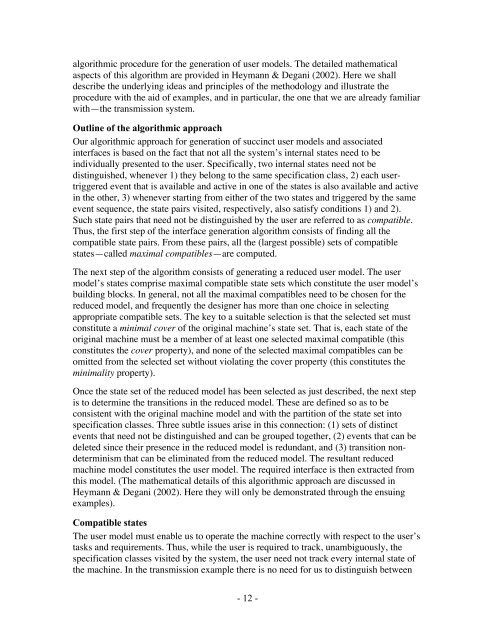formal analysis and automatic generation of user interfaces
formal analysis and automatic generation of user interfaces
formal analysis and automatic generation of user interfaces
Create successful ePaper yourself
Turn your PDF publications into a flip-book with our unique Google optimized e-Paper software.
algorithmic procedure for the <strong>generation</strong> <strong>of</strong> <strong>user</strong> models. The detailed mathematical<br />
aspects <strong>of</strong> this algorithm are provided in Heymann & Degani (2002). Here we shall<br />
describe the underlying ideas <strong>and</strong> principles <strong>of</strong> the methodology <strong>and</strong> illustrate the<br />
procedure with the aid <strong>of</strong> examples, <strong>and</strong> in particular, the one that we are already familiar<br />
with—the transmission system.<br />
Outline <strong>of</strong> the algorithmic approach<br />
Our algorithmic approach for <strong>generation</strong> <strong>of</strong> succinct <strong>user</strong> models <strong>and</strong> associated<br />
<strong>interfaces</strong> is based on the fact that not all the system’s internal states need to be<br />
individually presented to the <strong>user</strong>. Specifically, two internal states need not be<br />
distinguished, whenever 1) they belong to the same specification class, 2) each <strong>user</strong>triggered<br />
event that is available <strong>and</strong> active in one <strong>of</strong> the states is also available <strong>and</strong> active<br />
in the other, 3) whenever starting from either <strong>of</strong> the two states <strong>and</strong> triggered by the same<br />
event sequence, the state pairs visited, respectively, also satisfy conditions 1) <strong>and</strong> 2).<br />
Such state pairs that need not be distinguished by the <strong>user</strong> are referred to as compatible.<br />
Thus, the first step <strong>of</strong> the interface <strong>generation</strong> algorithm consists <strong>of</strong> finding all the<br />
compatible state pairs. From these pairs, all the (largest possible) sets <strong>of</strong> compatible<br />
states—called maximal compatibles—are computed.<br />
The next step <strong>of</strong> the algorithm consists <strong>of</strong> generating a reduced <strong>user</strong> model. The <strong>user</strong><br />
model’s states comprise maximal compatible state sets which constitute the <strong>user</strong> model’s<br />
building blocks. In general, not all the maximal compatibles need to be chosen for the<br />
reduced model, <strong>and</strong> frequently the designer has more than one choice in selecting<br />
appropriate compatible sets. The key to a suitable selection is that the selected set must<br />
constitute a minimal cover <strong>of</strong> the original machine’s state set. That is, each state <strong>of</strong> the<br />
original machine must be a member <strong>of</strong> at least one selected maximal compatible (this<br />
constitutes the cover property), <strong>and</strong> none <strong>of</strong> the selected maximal compatibles can be<br />
omitted from the selected set without violating the cover property (this constitutes the<br />
minimality property).<br />
Once the state set <strong>of</strong> the reduced model has been selected as just described, the next step<br />
is to determine the transitions in the reduced model. These are defined so as to be<br />
consistent with the original machine model <strong>and</strong> with the partition <strong>of</strong> the state set into<br />
specification classes. Three subtle issues arise in this connection: (1) sets <strong>of</strong> distinct<br />
events that need not be distinguished <strong>and</strong> can be grouped together, (2) events that can be<br />
deleted since their presence in the reduced model is redundant, <strong>and</strong> (3) transition nondeterminism<br />
that can be eliminated from the reduced model. The resultant reduced<br />
machine model constitutes the <strong>user</strong> model. The required interface is then extracted from<br />
this model. (The mathematical details <strong>of</strong> this algorithmic approach are discussed in<br />
Heymann & Degani (2002). Here they will only be demonstrated through the ensuing<br />
examples).<br />
Compatible states<br />
The <strong>user</strong> model must enable us to operate the machine correctly with respect to the <strong>user</strong>’s<br />
tasks <strong>and</strong> requirements. Thus, while the <strong>user</strong> is required to track, unambiguously, the<br />
specification classes visited by the system, the <strong>user</strong> need not track every internal state <strong>of</strong><br />
the machine. In the transmission example there is no need for us to distinguish between<br />
- 12 -

















